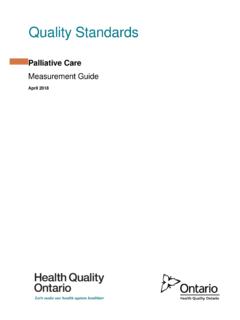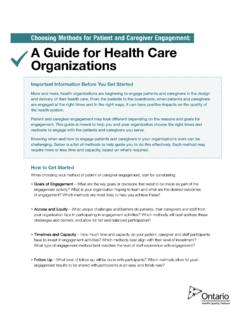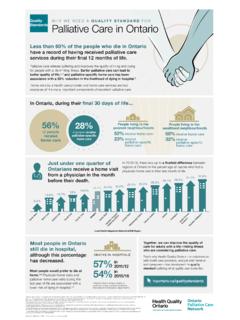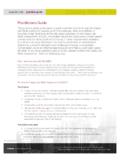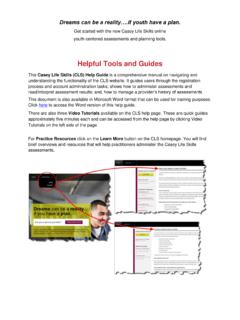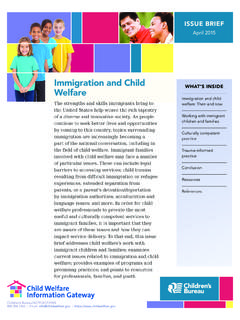Transcription of Resource Guide - Logic ModelFinal - HQOntario
1 Logic MODEL Resource Guide January 2010 Amended December 2010 ACKNOWLEDGEMENTS The Logic Model Resource Guide for family Health Teams is the result of the efforts of the Quality Improvement and Innovation Partnership s (QIIP) Evaluation, Needs Assessment and Performance Measures Working Group. The work of Christel Woodward, who compiled the Resource Guide on behalf of the working group, is gratefully acknowledged. Evaluation, Needs Assessment and Performance Measures Working Group Members Mike Green Chair Sten Ardal Paula Brauer Bill Casey Linda Hilts Brian Hutchison Sherry Kennedy Barbara Roston David Wallik Christel Woodward For additional information about other resources contact: Quality Improvement & Innovation Partnershi 2345 Argentia Rd, Suite 101 Mississauag, Ontario, Canada L5N 8K4 Phone: 905 363-0490 Fax: 905 363-0491 Individuals may reproduce these materials for their use provided that proper attribution is given to the appropriate source. The recommended citation for this Resource Guide is: Quality Improvement and Innovation Partnership (January 2009).
2 Logic Model Resource Guide for family Health Teams. QIIP is funded by the Ontario Ministry of Health and Long Term Care. The opinions expressed in this publication are those of the authors and do not reflect the official views of the Ontario Ministry of Health and Long Term Care. TABLE OF CONTENTS HOW TO USE THIS Guide .. 1 WHAT IS A PROGRAM? .. 1 THE Logic MODEL S ROLE IN EVALUATION: WHAT PURPOSES CAN A Logic MODEL SERVE? .. 1 DEVELOPING A Logic MODEL .. 3 Logic Model Components .. 3 HOW DO YOU START Logic MODEL DEVELOPMENT? .. 5 A Logic Model for the Smoking Cessation Program (an Example) .. 6 FURTHER READINGS AND RESOURCES .. 9 Logic Model Resource Guide for family Health Teams January 2010 Quality Improvement & Innovation Partnership 1 HOW TO USE THIS Guide This Guide is intended for health professionals working in family Health Teams (FHTs). It describes how Logic models are used in program planning and evaluation. A Logic model is a diagram that describes a program and shows the relationships among program components.
3 This Guide provides an example of a Logic model developed for a smoking cessation program. It points out how a Logic model can assist program planners with program choices and allow the program to be clearly described in a brief diagram. WHAT IS A PROGRAM? A program is a set of activities that are carried out to meet specific objectives or goals. Programs usually have some way of identifying/recruiting and assessing potentially eligible participants, providing participants with assistance of some kind (drugs, counseling, advice, surgery, and assistance with life style modification) and some way of determining when the person has left or completed the program and their status at that time. All of these activities comprise the program. In this Guide to Logic models, a smoking cessation program is used to illustrate how to develop a Logic model. The program goal is fairly clear. Yet, we will need to decide what we consider success. (For example, will reduction in smoking count or only complete cessation of smoking?)
4 If so, how long must cessation be present?). In completing the Logic model, we will need to sort through for whom the program is intended and the activities required to carry out the program. What outcomes we attribute to the program will also need to be clarified. As you will later see, a Logic model can also help us identify the staffing needed to carry out the program. THE Logic MODEL S ROLE IN EVALUATION: WHAT PURPOSES CAN A Logic MODEL SERVE? Logic models were developed as tools to clarify the nature of a program and its intended effects. A Logic model of the program is a useful planning tool that provides a diagrammatic description of a program by depicting its goals and objectives, the component activities needed to accomplish the goals, their outputs (countable by products of each component), short and long term outcomes (direct results or accomplishments) and impacts (effects for which the program can claim only partial responsibility). It is a clear, concise tool for communicating with others about the program.
5 It helps identify all of the tasks required for program implementation. It allows examination of assumptions about how a new program (or changes in a program) will produce the effects intended. The Logic model may reveal that some activities needed for a program to have some of its intended effects are not yet part of the program. Conversely, it can point out that some on going activities are not well linked to program objectives. Logic Model Resource Guide for family Health Teams January 2010 Quality Improvement & Innovation Partnership 2 A Logic model spells out how the program works. It describes the activities that are a part of the program and the changes you expect if these activities are carried out as planned. It sets out the answer to the basic question: How does change occur in this program? Table 1: Purpose of a Logic Model Plan / Review Programs Ensure Program Integrity Communication Tool Evaluation Aid clarify program goals and assumptions assess need for program think through activities needed to carry out program think through staffing implications examine likely outcomes and possible impacts of program monitor program performance identify if planned processes are being followed describe program clearly be concise ensure common understanding of program improve program accountability identify how success will be measured target both processes used and outcomes to be achieved A Logic model provides a program overview that helps everyone understand how the program works and the assumptions that underlie its delivery.
6 It is a useful communication aid. It allows a common understanding of the program to develop among the people who are involved in developing the program, those delivering it and others who have a stake in its success. A Logic model can be useful not only in program planning and implementation but also in reviewing existing programs. It helps ensure the program s goals are clear and that the activities undertaken allow the program s mission to be achieved. Programs tend to evolve over time; thus, the assumptions underlying how the program is currently delivered may be vaguely understood. By clarifying these basic assumptions, their validity can be examined. Sometimes, it even allows us to know that our program has been so successful that it is no longer needed. A Logic model is a useful evaluation tool because it readily identifies the processes and outcomes that should be measured to determine whether our program has been implemented successfully and is producing the outcomes expected.
7 It allows clarification of the outcomes expected and helps develop a mutually shared definition of success for this program. Logic Model Resource Guide for family Health Teams January 2010 Quality Improvement & Innovation Partnership 3 DEVELOPING A Logic MODEL Logic Model Components Goal: What is the overall purpose of your program? Why are you doing it? What a program is trying to achieve and how it goes about achieving it may seem clear; but, sometimes asking questions about what the program s goals are and how they are achieved can reveal ambiguities. For example, in our smoking cessation example, the goal of the program may be to help smokers in the practice to stop smoking. Or, we may say that the goal of the program is to reduce the number of smokers in the practice to less than 10% of patients on the roster. How we state our goal has implications for how the program is carried out and how it will be evaluated. In the Logic model developed for smoking cessation, the goal chosen is to help smokers in the practice to stop smoking and remain non smokers for a year.
8 Participants: For whom is your program designed? Who will benefit from it? The people the program is intended to help are the program participants. They will receive a direct benefit from the program if it is successful. Participants are also sometimes called recipients. We prefer the term participants as it suggests active involvement rather than passive participation. We need to decide whether we are trying to help those who are current smokers with our program or are also interested in preventing more patients from becoming smokers. If both current and possible future smokers are our target group, the program will have different components than if the program is limited to those who currently smoke. The age group targeted by the program is also important and may lead to the refinement of our goal. The Logic model developed assumes that the program is targeted at current smokers in the practice who are at least 16 years of age and hopes to assist them in quitting smoking. Activities: What activities are needed to run the program?
9 It is instructive to develop a step by step list of all the activities that a program comprises by describing how a patient enters the program, what happens while they are in the program and how discharge occurs. Usually some mechanisms are required for identification or intake of possible program participants, some assessment activities, some activities that may be seen as therapeutic, educational or supporting behaviour change and some activities related to termination of the person in the program. Sometimes the program will have print materials for participants to read and take home. Technologies may be used to support the program ( , swab from mouth for cotinine). In our smoking cessation program, we might decide to identify smokers by asking every patient seen in the practice by a health professional if they currently smoke. To avoid asking non smokers repeatedly if they smoke, screened patients (who have had their smoking status ascertained) will have a flag on their chart covers.
10 A special flag will indicate the patients who are smokers so that they will be asked again about their smoking status and interest in the program during subsequent visits. If someone drops out from the program or is not a non smoker when contacted six or 12 months after they ceased smoking, the medical chart will again have the special flag to indicate that they are a smoker). Logic Model Resource Guide for family Health Teams January 2010 Quality Improvement & Innovation Partnership 4 The health professional seeing the patient will ask the smoker whether they are interested in attempting to quit and describe the program available to help them quit. If they are interested, their name will be given to the staff member (or one of the staff) in charge of intake to the program. This person will contact the smoker, schedule an appointment to discuss their smoking behavior, ascertain their smoking history, whether (and how) they have tried to quit previously, the outcome(s) of their attempt(s), the longest period that they have not smoked during previous attempts, perceived reasons for relapse, The staff will then work with the smoker to tailor a quitting strategy that has proven successful for other smokers and matches this smoker s needs.

